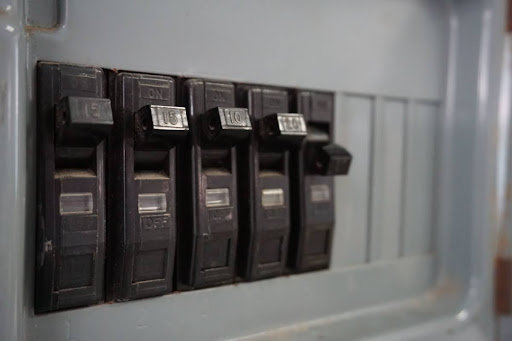Your electrical panel stands guard 24/7, protecting against electrical fires and damage to your expensive electronics. Its job is simple: when it detects a problem, it cuts the power to that circuit.
A single trip now and then is no big deal. But if you have a breaker that keeps tripping over and over, your home is sending you a clear signal that something isn’t right.
It could be something simple, or it could be a sign of a more serious issue lurking in your walls. You just want the flickering lights and sudden power outages to stop. You want to know what’s going on and, more importantly, how to fix it.
The Overloaded Circuit
This is the most common reason a breaker trips. An overloaded circuit is exactly what it sounds like: you’re asking a single circuit to provide more power than it was built to handle. Think of your kitchen. If you’re running the microwave, the toaster oven, and the coffee maker all at the same time on the same circuit, you’re creating a huge demand for electricity.
The breaker feels this massive power draw, heats up, and trips to prevent the circuit wiring from overheating and becoming a fire hazard.
Dealing With a Short Circuit
A short circuit is a more serious problem than an overload. This happens when a “hot” electrical wire makes contact with a “neutral” wire. This creates a shortcut for the electricity, causing a massive and immediate surge of current to flow through the circuit.
When this happens, the breaker trips instantly. It’s a violent, fast reaction designed to stop that powerful surge from causing a fire. Short circuits are often caused by damaged wiring inside your walls, old or faulty appliance cords, or loose connections inside an outlet box. A short circuit is a genuine fire risk and needs to be addressed right away.
The Ground Fault
A ground fault is similar to a short circuit. It happens when a “hot” wire touches a ground wire or a grounded metal part of an appliance or electrical box. This creates an alternative path for the electricity to flow to the ground, which can be incredibly dangerous if that path happens to be through a person.
This is why you have those special GFCI outlets (the ones with the “test” and “reset” buttons) in your bathrooms, kitchen, and outdoors. A ground fault trip is your system’s way of protecting you from a nasty electrical shock. Like a short circuit, it points to a problem with an appliance or your home’s wiring.
Here are a few other possibilities for a tripping breaker:
- An old, weak, or faulty circuit breaker that needs replacement.
- Loose wiring connections inside your electrical panel.
- A major power surge from a lightning strike.
- An issue with the utility company’s equipment outside your home.
How to Handle an Overloaded Circuit
If your breaker trips, the first thing to do is figure out what caused it. For a simple overload, the fix is a process of elimination. First, head to the room that lost power and unplug everything that was running on that circuit.
Next, go to your electrical panel. Find the tripped breaker (it will be flipped to the middle or “off” position). Push it firmly all the way to the “off” position, and then flip it back to “on.” If the power stays on, you were likely dealing with an overload. Now you can start plugging things back in, but be strategic.
Try not to run all your high-power gadgets at once. You may need to spread them out across different circuits or consider getting a dedicated circuit for a power-hungry appliance.
What to Do About a Short Circuit
If you reset the breaker and it immediately snaps back off with a “click,” you probably have a short circuit. Do not keep trying to reset it. This is a clear warning sign.
This is where you need to stop and call for professional help. A short circuit isn’t a DIY fix. The problem could be a damaged wire hidden in a wall or a fault deep inside an appliance. A licensed electrician has the right tools to trace the source of the short and perform a safe electrical repair. Trying to fix this yourself can be a major fire hazard.
Fixing Ground Faults and Other Issues
A ground fault will also cause a breaker to trip immediately upon being reset. Just like a short circuit, this points to a fault in an appliance or your home’s wiring that needs a professional eye. The risk of electrical shock is too high to take chances. A professional can locate the source of the fault and make your home safe again.
Solving Those Other Breaker Problems
- A Faulty Breaker: Breakers don’t last forever. They can weaken with age and trip even when there’s no overload. A licensed electrician can test your breakers and perform a new circuit breaker installation if one is failing.
- Loose Connections: Over time, the wiring inside your electrical panel can become loose. This creates heat and can cause breakers to trip. An electrician needs to safely open your panel and tighten these connections.
- Power Surges: The best defense against lightning or utility surges is a whole-home surge protector. This device is installed at your main electrical panel and protects your entire home from damaging voltage spikes.
Don’t Ignore a Tripping Breaker
A circuit breaker that keeps tripping is screaming for your attention. It’s your home’s way of telling you there’s a problem that could lead to a fire or electrical shock. Stop the guessing game and get a real answer.
The team at A1 Plus Electrical, Plumbing and Air can pinpoint the exact cause of your electrical issues. From a professional circuit breaker installation to complex electrical repair work, we have the skills to get your home’s power system back in safe, reliable working order. Give us a call today to schedule an appointment in Houston, TX, or one of the nearby areas, and let us take care of it for you!

